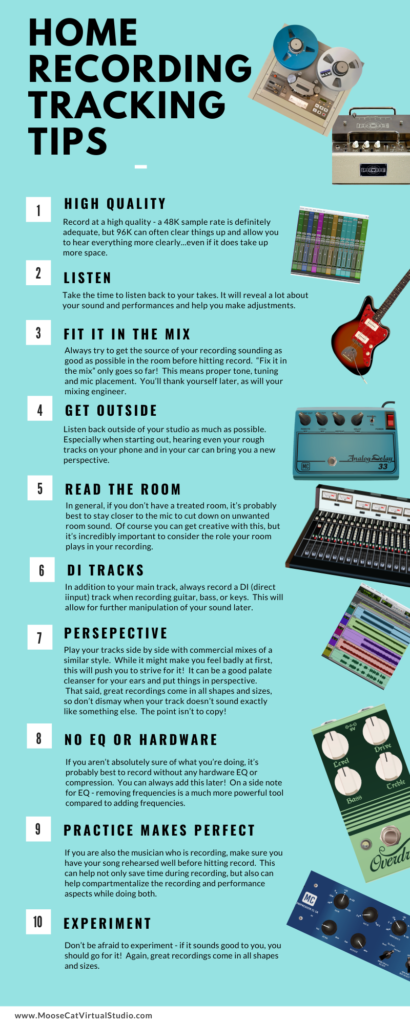Home Recording Tracking Tips

Here are some basic tips and tricks to follow when recording at home!
- Record at a high quality – a 48K sample rate is definitely adequate, but 96K can often clear things up and allow you to hear everything more clearly. Even if it does take up more space. Please note having a high quality interface will make a difference here in terms of the difference you can hear between the two.
- Take the time to listen back to your takes. It will reveal a lot about your sound and performances.
- Always get the source of your recording sounding as good as possible in the room before hitting record. “Fix it in the mix” only goes so far! This means proper tone, tuning and mic placement. You’ll thank yourself later – as will your mixing engineer.
- Listen back outside of your studio as much as possible. Especially when starting out, hearing even your rough tracks on your phone and in your car can bring you a new perspective.
- In general, if you don’t have a treated room, it’s probably best to stay closer to the mic to cut down on unwanted room sound. Of course you can get creative with this, but it’s incredibly important to consider the role your room plays in your recording.
- In addition to your main track, always record a direct DI track when recording guitar, bass, or keys. This will allow for further manipulation of your sound later.
- Play your tracks side by side with commercial mixes of similar style. While it might make you feel badly at first, this will push you to strive for it! It can also be a good palate cleanser and put things in perspective. That said, great recordings come in all shapes and sizes, so don’t dismay when your track doesn’t sound exactly like something else. The point isn’t to copy!
- If you aren’t absolutely sure of what you’re doing, it’s probably best to record without any hardware EQ or compression. You can always add this later! On a side note for EQ – removing frequencies is a much more powerful tool compared to adding.
- Practice makes perfect! If you are also the musician who is recording, make sure you have your song rehearsed well before hitting record. This can help not only save time during recording, but also can help compartmentalize the recording and performance aspects while doing both.
- Don’t be afraid to experiment – if it sounds good to you, you should go for it! Again, great recordings come in all shapes and sizes.
